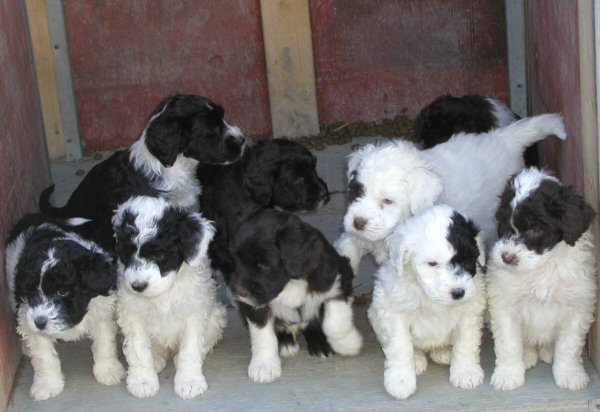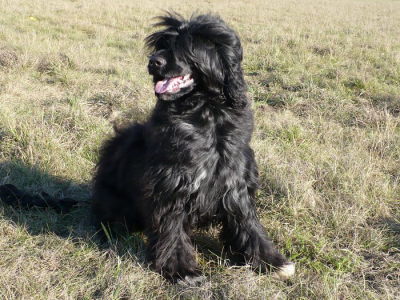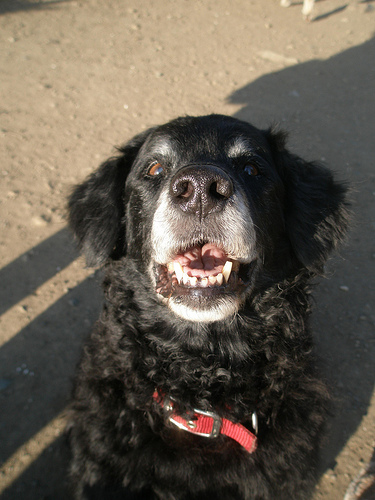| |
|
|
Portuguese Water Dog Information

Portuguese Water Dog Facts
| Size |
Medium |
| Male Max Weight |
42-60 lb |
| Female Max Weight |
35-50 lb |
| Life Span |
10-14 years |
| Energy Level |
 |
| Ease of Training |
 |
| Grooming |
 |
| Shedding |

|
| Exercise Requirements |

|
| Playfulness |

|
| Affection Level |

|
| Good With Dogs |

|
| Good With Pets |

|
| Good With Strangers |

|
| Watchdog Ability |

|
| Protection Ability |

|
| Cold Tolerance |

|
| Heat Tolerance |

|
Portuguese Water Dog Temperament
|
The Portuguese Water Dog is an extrovert that enjoys being with the family and
being in water. It is kind and listens to directions. This breed gets along well
with children and with other animals. The Portuguese Water Dog is ideal for a person or a
family that is high energy and looking for a pet with the same
qualities.
|
Portuguese Water Dog Upkeep
|
The Portuguese Water Dog is a high energy breed that requires
both mental and physical stimulation on a daily basis. The physical needs can be
met with a walk, a jog, a play session, or a swim. This breed enjoys the
opportunity to participate in activities both indoors and outdoors. The coat of the
Portuguese Water Dog requires combing a few times per week in addition to clipping or
scissoring once each month.
|
Portuguese Water Dog Health
|
The major health concern for the Portuguese Water Dog is PRA (progressive
retinal atrophy). Some of the minor health concerns for this breed include GM1 storage
disease, distichiasis, Addison’s, CHD (canine hip Dysplasia), juvenile cardiomyopathy, and
follicular Dysplasia. Occasionally seen in this breed are irritable bowel syndrome and
seizures. It is suggested that regular testing of the eyes, hips, and DNA occur.
The average life span of a healthy Portuguese Water Dog is 10 to 14
years.
|
Portuguese Water Dog History
|
The Portuguese Water Dog is derived from herding dogs located in the central
region of Asia. It is also thought that this breed may share some of its heritage with
the Poodle breed. The specific time that the Portuguese Water Dog arrived in Portugal is
uncertain. One belief is that the Visigoths brought the breed into Portugal during the
fifth century. Another theory is that this breed arrived in Portugal in the eighth
century by way of the Berbers and Moors. The water loving Portuguese Water Dog made a
name for itself in Portugal with its ability to assist in fishing expeditions by herding and
retrieving nets and other fishing equipment in the water. The breed also became a part of
fishing expeditions between Iceland and Portugal. The Portuguese Water Dog was initially
called the Cao de Agua, which refers to its affinity towards water. There are two
varieties of this breed, which are the Cao de Agua de Pelo Ondulado and the Cao de Agua de Pelo
Encaradolado. The first being the long-haired version and the latter being the
curly-haired version. As the techniques for fishing began to change, the presence of the
Portuguese Water Dog began to diminish. Dr. Vasco Bensuade is thought to be responsible
for the rescue and promotion of the Portuguese Water Dog and his efforts led to a standard
being written. This breed started to be shown in the show ring as well. During the
1950’s, the Portuguese Water Dog had made an emergence in England but this quickly ended.
During the same time, the Portuguese Water Dog arrived in America and in 1984 became recognized
by the AKC. The popularity of this breed continues to grow in America as a family dog
instead of a water working dog.
|
Portuguese Water Dog Pictures
|
Puppies

Middle Aged

Older

|
Portuguese Water Dog Videos
|
|
|








